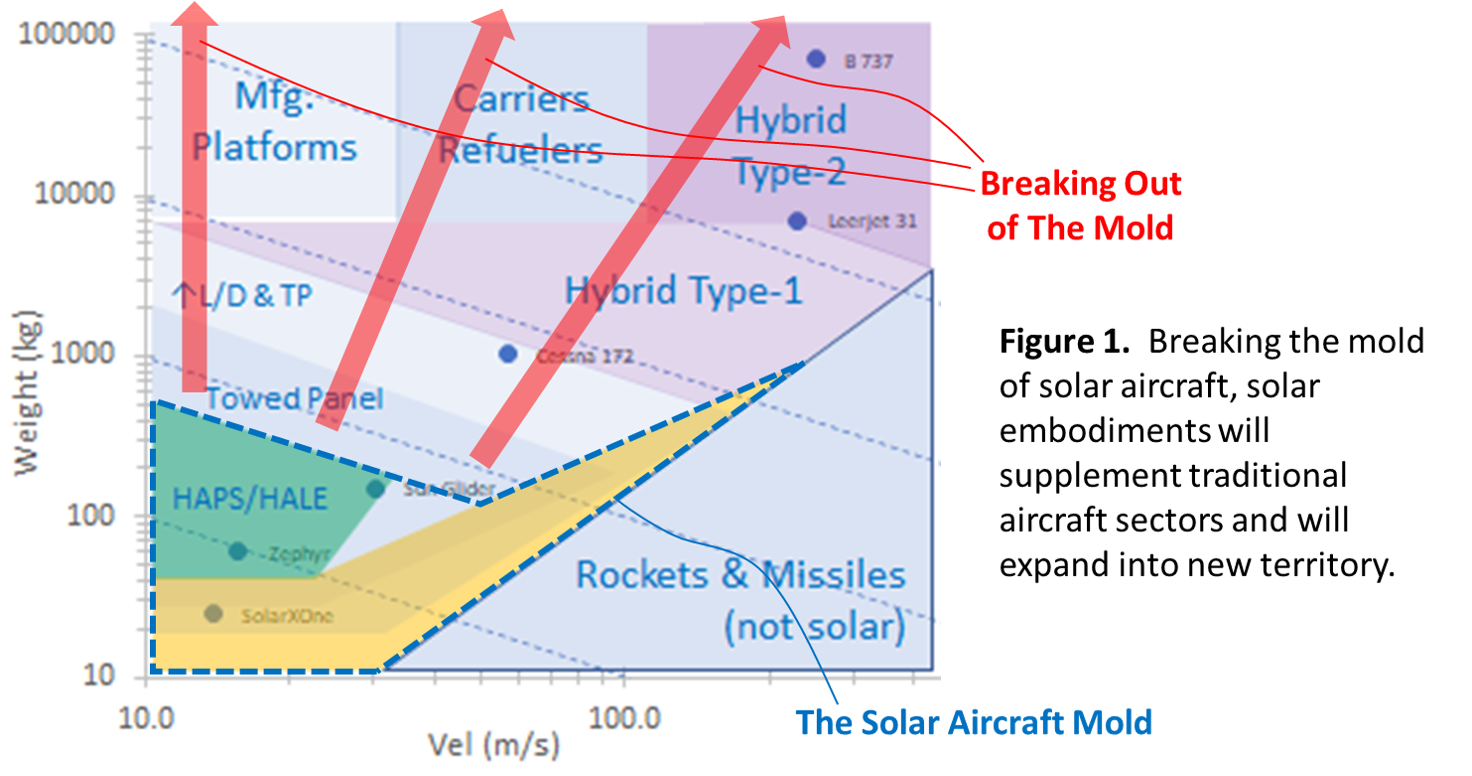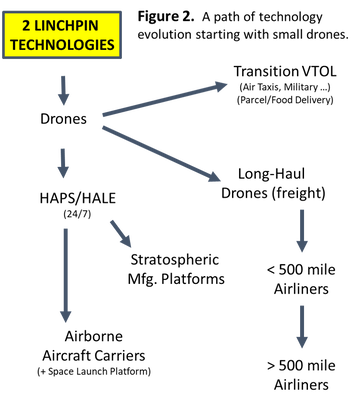May 2023 NSF PITCH
TECHNICAL INNOVATION
A large energy efficiency gap exists between current airliners and new designs like the NASA’s SUSAN and Boeing’s SUGAR volt. An even bigger gap exists between today’s quadcopters and new transition VTOL concepts. Add to this to reduced costs and weights of photovoltaic cells and batteries, and a landscape emerges for high impact of unproven innovations in transportation. This Phase 1 project uses two fundamentally aligned innovations toward the building of a drone airframe prototype (i.e. practical) and providing a bill of materials for a (Phase 2) scaled-up solar-powered version of that airframe prototype.
An expanding patent portfolio on these technologies started in 2019 with transition VTOL technology, evolved to using towed platforms in cruising configurations for improved efficiency and solar power, and (in 2023) was refined with computational fluid dynamics (“CFD”) to verify and further improve. The two innovations to be evaluated in Phase 1 are:
#1 TECH1 is based on towed platform technology that provides a 5X increase in surface area, versus contemporary wings, for solar panels. The platforms passively align to optimal lift positions, transforming a structure of unstable pitch to passively stable.
CONTENT DELETED .
#2 TECH2 is the strategic CONTENT DELETED .
The result is two linchpin technologies that can “break the mold” as illustrated by Figure 1. Rather than having five different approaches for five different types of aircraft; one approach with two linchpin technologies can evolve through existing aircraft markets and create new aircraft markets like airborne aircraft carriers, stratospheric manufacturing platforms, and electric refueler aircraft. DARPA is currently developing wireless energy transfer that further expands capabilities.
As illustrated by Figure 1, the drones of this project will be faster; they will also have extended flight times and ranges up to and including 24/7. Figure 2 illustrates how the linchpin products will evolve through and beyond today’s aircraft sectors.
A large energy efficiency gap exists between current airliners and new designs like the NASA’s SUSAN and Boeing’s SUGAR volt. An even bigger gap exists between today’s quadcopters and new transition VTOL concepts. Add to this to reduced costs and weights of photovoltaic cells and batteries, and a landscape emerges for high impact of unproven innovations in transportation. This Phase 1 project uses two fundamentally aligned innovations toward the building of a drone airframe prototype (i.e. practical) and providing a bill of materials for a (Phase 2) scaled-up solar-powered version of that airframe prototype.
An expanding patent portfolio on these technologies started in 2019 with transition VTOL technology, evolved to using towed platforms in cruising configurations for improved efficiency and solar power, and (in 2023) was refined with computational fluid dynamics (“CFD”) to verify and further improve. The two innovations to be evaluated in Phase 1 are:
#1 TECH1 is based on towed platform technology that provides a 5X increase in surface area, versus contemporary wings, for solar panels. The platforms passively align to optimal lift positions, transforming a structure of unstable pitch to passively stable.
CONTENT DELETED .
#2 TECH2 is the strategic CONTENT DELETED .
The result is two linchpin technologies that can “break the mold” as illustrated by Figure 1. Rather than having five different approaches for five different types of aircraft; one approach with two linchpin technologies can evolve through existing aircraft markets and create new aircraft markets like airborne aircraft carriers, stratospheric manufacturing platforms, and electric refueler aircraft. DARPA is currently developing wireless energy transfer that further expands capabilities.
As illustrated by Figure 1, the drones of this project will be faster; they will also have extended flight times and ranges up to and including 24/7. Figure 2 illustrates how the linchpin products will evolve through and beyond today’s aircraft sectors.
|
TECHNICAL OBJECTIVES AND CHALLENGES
It has been seven years since the first around-the-world solar-powered flight, and a similar time since SUSAN and TECH2-type concepts have emerged. More recently, an abundance of transition air taxi concepts have emerged to substantially improve the efficiency of VTOL aircraft. The billion-dollar rollout costs of airliner advances quantify the huge challenges. This project is based on one set of core technologies that can evolve from initial small drone prototypes to airliners, transition VTOL, HAPS/HALE, and flying platforms (i.e., manufacturing, carriers). The cost reduces from billions of dollars to few million before cash flow from initial products are able to sustain the path of evolution. Even the timelines are shorter—it is substantially about the right scalable approaches. It is also about a rigor in details and science to get the right/complete information from every experiment; this is where over 40 years of experience in leading R&D is irreplaceable. |
OBJECTIVES – The objectives of this Phase 1 include:
THE MARKET OPPORTUNITY
Large segments of society (bottom up market drivers) want the following:
A sequence of 4 products (first of dozens) will be pursued starting about 3 months into a Phase 1 project:
#1 Kits for RC hobbyists to assemble and fly: the pain point is the low flight time of battery electric vehicles and the “joy” point is to be part of cutting edge technology to solve the above pain points for society.
#2 Kits for High School Teams/Classes/Groups along with education modules: the pain points are the limited learning and technology exposure upside of current drone kits (which focus primarily on control programming for quadcopters).
#3 Reconnaissance drones of the $2,000 price range for businesses such as farms, forestry, and photography: the pain point of existing products are the slow velocities and battery limits of flight times.
#4 Reconnaissance drones of the $5,000 to $20,000 price range for government groups for reconnaissance and eyes-in-the-sky to assist first responders and security/military operations: Pain points are labor intensity of using current products.
COMPANY AND TEAMSince 2017, the employee-owner of Homeland Technologies is Galen Suppes PhD PE. Dr. Suppes is an AIChE Fellow with over 40 years of experience, over 125 refereed publications having over 7500 citations, and advisor of 16 PhD graduates. Dr. Suppes does the following:-identifies/refines theoretical foundations,-performs CAD/STL design followed by prototyping (including 3D printing, wood/plastic/metal working),-programs computer/controller code,-tests and evaluates the performance of prototypes,-maintains the web sites HS-Drone.com and terretrans.com,-writes and prosecutes patents,-documents and publishes advances through refereed papers, and-writes proposals and seeks funding. Dr. Suppes has advanced the HS-Drone product through patent writing and prosecution as well as the current prototype that can take off and fly.
Adam Suppes, PhD, is a part time employee. Adam received his PhD in December of 2022 in Chemical and Biomolecular Engineering from The University of Pennsylvania. His PhD studies were intensive in fluid dynamics flow phenomena, and since graduation he has focused on CFD simulations for the embodiments of this project. Adam is a contributor to the patent applications of 2023 on this project.
The patent portfolio includes:
Four new unpublished applications (filed Oct-2022, Nov-2022, Mar-2023, May-2023)
Published Applications (all active in at least one country):
- PCT/US21/16392 & US 17/795612 Flat Plate Airfoil Platform Vehicle
- PCT/US22/14884 & US 17/591034 Hybrid Engine and Aircraft Application
Issued Patents:
- US 11,186,367 Multicopter with Improved Propulsor and Failsafe Operation
- US 10,589,838 Multicopter with Passively-Adjusting Tiltwing
- Perform CFD experiments to substantiate and optimize TECH1 and TECH2 improvements as possible using computer-based simulation (and strengthen patent position of current provisional applications before conversion to PCT applications in 2024).
- Fabricate, fly, and characterize the performance of airframe prototypes at the 300-1000 gram scale.
- Prepare a paper study with design details and bill of materials for an initial Phase 2 prototype that will take the airframe prototype to a solar-powered prototype.
- Perform outreach to customers and collaborators including the introduction of the first product which will be a kit to allow hobbyists to fabricate their on aircraft using these technologies.
- CFD on TECH2 technology – aspects of TECH2 type technology (but not applied to towed panel aircraft) have been around for years, and yet there are no publications targeting an understanding of how to optimize implementation (e.g., risk versus reward, cost versus gain). Preliminary studies have been made progress on this topic. R&D is about the understanding gained and getting the most information; that will be achieved.
- Fabrication Methods – 3D printing has greatly expanded what is possible in efficient generation of prototypes. However, optimal configurations will use board stock (e.g., carbon fiber board), pivotable joints, and a range of servos. This fabrication is R&D and innovation on a constant basis.
- Takeoff, Landing, Control – SolarXOne is perhaps the best commercially available solar aircraft, it takes off on a ramp and belly lands. Takeoff, landing, and control is a challenge that goes beyond a design that has a good cruising configuration. Today’s patent literature (including work originating from NASA) continues to address these issues.
THE MARKET OPPORTUNITY
Large segments of society (bottom up market drivers) want the following:
- An end to greenhouse-gas-generating transportation,
- Improved safety and emergency care through better eyes-in-the-sky and transportation by first responders and ambulatory services,
- Military dominance by a country that is not looking/acting to invade its neighbor and pit sister against brother in warfare,
- Less time on roads commuting,
- Low-cost delivery of items ranging from Amazon purchases to groceries, and
- Lower-cost and faster transit that goes farther.
A sequence of 4 products (first of dozens) will be pursued starting about 3 months into a Phase 1 project:
#1 Kits for RC hobbyists to assemble and fly: the pain point is the low flight time of battery electric vehicles and the “joy” point is to be part of cutting edge technology to solve the above pain points for society.
#2 Kits for High School Teams/Classes/Groups along with education modules: the pain points are the limited learning and technology exposure upside of current drone kits (which focus primarily on control programming for quadcopters).
#3 Reconnaissance drones of the $2,000 price range for businesses such as farms, forestry, and photography: the pain point of existing products are the slow velocities and battery limits of flight times.
#4 Reconnaissance drones of the $5,000 to $20,000 price range for government groups for reconnaissance and eyes-in-the-sky to assist first responders and security/military operations: Pain points are labor intensity of using current products.
COMPANY AND TEAMSince 2017, the employee-owner of Homeland Technologies is Galen Suppes PhD PE. Dr. Suppes is an AIChE Fellow with over 40 years of experience, over 125 refereed publications having over 7500 citations, and advisor of 16 PhD graduates. Dr. Suppes does the following:-identifies/refines theoretical foundations,-performs CAD/STL design followed by prototyping (including 3D printing, wood/plastic/metal working),-programs computer/controller code,-tests and evaluates the performance of prototypes,-maintains the web sites HS-Drone.com and terretrans.com,-writes and prosecutes patents,-documents and publishes advances through refereed papers, and-writes proposals and seeks funding. Dr. Suppes has advanced the HS-Drone product through patent writing and prosecution as well as the current prototype that can take off and fly.
Adam Suppes, PhD, is a part time employee. Adam received his PhD in December of 2022 in Chemical and Biomolecular Engineering from The University of Pennsylvania. His PhD studies were intensive in fluid dynamics flow phenomena, and since graduation he has focused on CFD simulations for the embodiments of this project. Adam is a contributor to the patent applications of 2023 on this project.
The patent portfolio includes:
Four new unpublished applications (filed Oct-2022, Nov-2022, Mar-2023, May-2023)
Published Applications (all active in at least one country):
- PCT/US21/16392 & US 17/795612 Flat Plate Airfoil Platform Vehicle
- PCT/US22/14884 & US 17/591034 Hybrid Engine and Aircraft Application
Issued Patents:
- US 11,186,367 Multicopter with Improved Propulsor and Failsafe Operation
- US 10,589,838 Multicopter with Passively-Adjusting Tiltwing

